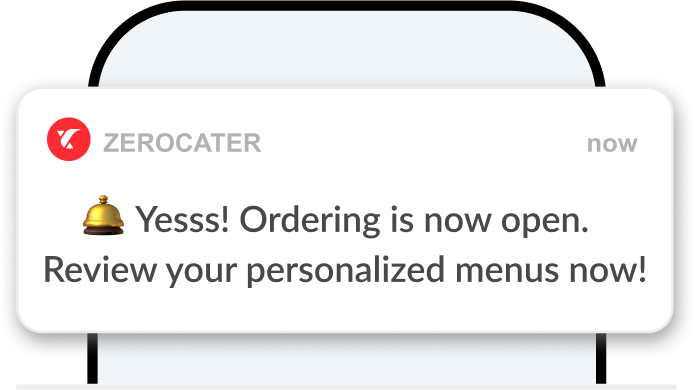The Tuesday 2 PM Energy Crisis: Why Your Office Lunch Strategy Determines Afternoon Productivity
Sarah from accounting is face-down on her keyboard again. Mike’s third coffee run of the day isn’t fooling anyone. And that important 3 PM client presentation? Let’s just say the energy in the room feels more “sleepy village” than “dynamic startup.”
Welcome to the post-lunch productivity crash—a phenomenon so predictable that smart companies have started treating catered office lunches as performance management tools rather than simple employee perks.
The Neuroscience of Workplace Lunch Timing
Forget everything you think you know about the sacred noon hour. Cutting-edge research in chronobiology reveals that optimal meal timing varies dramatically based on individual circadian rhythms, morning caffeine consumption, and cognitive load patterns.
Peak Performance Lunch Scheduling
Forward-thinking companies now stagger lunch deliveries based on team functions:
- Creative teams perform best with 11:15 AM fuel-ups before afternoon brainstorming sessions
- Data analysts show 34% better accuracy with 12:45 PM meals that prevent mid-afternoon glucose crashes
- Client-facing roles benefit from 1:15 PM catering that energizes late-afternoon calls
- Remote collaboration teams optimize around global timezone overlaps rather than local hunger cues
The most sophisticated programs use individual productivity tracking to customize meal timing recommendations for different personality types and work styles.
Office Lunch Catering as Retention Warfare
In today’s talent market, lunch programs have evolved into competitive weapons. Companies aren’t just feeding employees—they’re broadcasting culture, values, and long-term investment philosophy through daily food choices.
Strategic Messaging Through Menu Curation
Your catering decisions send powerful recruitment and retention signals:
- Local artisan partnerships demonstrate community investment and authenticity
- Rotating international cuisines signal diversity, inclusion, and global thinking
- Sustainable sourcing transparency attracts environmentally conscious top performers
- Dietary customization capabilities show individual attention and care
The companies winning talent wars understand that lunch programs create daily touchpoints reinforcing “this is a place that values me” messaging.
The Hidden Psychology of Shared Meal Experiences
Harvard Business School research consistently shows that teams eating together demonstrate measurably higher collaboration, trust, and creative problem-solving. But here’s the twist: not all shared meals create equal bonding effects.
Optimizing Social Dynamics Through Food Format
Different catering styles produce dramatically different team outcomes:
- Family-style service builds cooperation through shared serving responsibilities
- Interactive food stations create natural conversation starters across departments
- Potluck-style hybrid programs where catering supplements employee contributions
- Themed cultural experiences that encourage learning and discussion
The most effective programs intentionally design social interaction rather than leaving team bonding to chance.
Technology-Driven Personalization in Office Lunch Programs
AI-powered catering platforms now analyze individual consumption patterns, dietary preferences, and even biometric data to optimize both personal nutrition and organizational efficiency.
Smart Systems That Learn Your Team’s Preferences
Modern lunch management technology includes:
- Predictive ordering algorithms that adjust quantities based on meeting schedules and historical data
- Nutrition optimization engines balancing individual health goals with group satisfaction
- Waste reduction analytics identifying overconsumption patterns and ingredient inefficiencies
- Budget optimization models that maximize satisfaction within spending constraints
Some platforms integrate with fitness trackers and health apps, creating personalized meal recommendations that support individual wellness goals while maintaining group cohesion.
Budget Engineering: Maximum Impact per Dollar Spent
The most successful office lunch programs treat budget allocation as strategic resource deployment rather than simple cost management. This mindset shift unlocks creative approaches that deliver outsized value.
Cost-Effectiveness Strategies That Scale
Smart budget management involves:
- Anchor vendor relationships providing baseline consistency with premium rotation options
- Employee contribution models where subsidized rather than fully-funded meals increase perceived value
- Bulk purchasing cooperatives with neighboring companies to access enterprise pricing
- Seasonal ingredient optimization taking advantage of local availability and pricing cycles
Progressive companies also factor employee time value into cost calculations, recognizing that reducing lunch-related logistics saves significant productivity hours.
Regional Flavor Profiles That Build Company Identity
Your lunch program can become a defining characteristic of company culture. Some organizations become known for their Tuesday taco bars, others for their partnership with local ethnic restaurants, still others for their commitment to farm-to-table sourcing.
Creating Signature Food Experiences
Memorable lunch programs often feature:
- Signature dishes that become part of company lore and recruitment conversations
- Local celebrity chef partnerships that create buzz and external recognition
- Seasonal celebration meals marking business milestones with special catering experiences
- Cultural education components where international cuisine comes with brief presentations about origins and traditions
These distinctive elements transform routine meals into company brand differentiators.
Health and Wellness Integration Beyond Basic Nutrition
Modern office lunch catering serves as a delivery mechanism for comprehensive wellness programming. Smart companies integrate nutritional education, mindful eating practices, and even mental health support into meal experiences.
Holistic Wellness Through Workplace Dining
Progressive approaches include:
- Nutritionist-designed rotating menus with educational components about ingredient benefits
- Mindful eating workshops conducted during lunch periods with expert facilitation
- Stress-reduction meal timing strategically deployed during high-pressure project periods
- Energy optimization coaching helping employees understand personal nutrition-productivity connections
The goal extends beyond feeding people toward supporting overall employee wellbeing and performance optimization.
Crisis Management: When Office Lunch Catering Goes Wrong
Every office manager has lunch catering horror stories: late deliveries during important client visits, food poisoning incidents, or vendor no-shows during all-hands meetings. The companies that handle these crises gracefully often emerge with stronger employee relationships.
Contingency Planning for Catering Emergencies
Robust lunch programs include:
- Backup vendor relationships with guaranteed emergency response capabilities
- Emergency food supplies for unexpected delivery failures or weather disruptions
- Communication protocols that keep employees informed during catering disruptions
- Recovery strategies that turn problems into opportunities for employee engagement
The most resilient programs treat occasional failures as trust-building opportunities rather than operational disasters.
Sustainability Metrics That Matter to Modern Employees
Environmental responsibility in office lunch programs extends far beyond recyclable containers. Today’s workforce increasingly evaluates employers based on comprehensive sustainability practices, including food sourcing, waste management, and local economic impact.
Measurable Environmental Impact Strategies
Leading programs track and report:
- Carbon footprint reduction through local sourcing and seasonal menu planning
- Waste stream optimization with detailed composting and recycling protocols
- Local economic impact measuring dollars flowing to community businesses
- Packaging innovation pioneering reusable and truly biodegradable serving materials
These metrics often influence recruiting decisions, particularly among younger professionals who prioritize environmental responsibility in employer selection.
Future-Proofing Your Lunch Strategy for Hybrid Workforces
As office attendance patterns continue evolving, lunch programs must adapt to serve both in-person and remote team members effectively. The most innovative companies are already experimenting with hybrid approaches that maintain team cohesion across distributed workforces.
The strategic companies recognize that office lunch catering in the hybrid era becomes more precious and purposeful. Every shared meal represents an opportunity to strengthen relationships and reinforce culture among team members who might only gather physically once or twice per week.
Your lunch program isn’t just about food—it’s about building the kind of workplace community that attracts top talent, retains key performers, and creates the collaborative energy that drives business success.
 to plan your catering
to plan your catering

